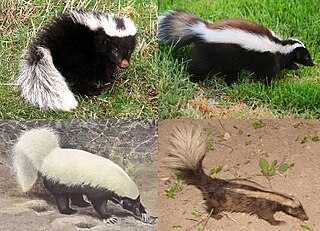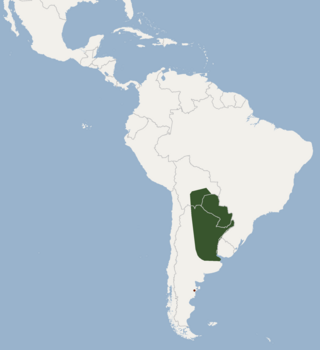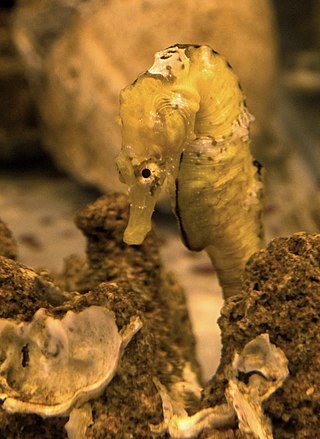
The stoat, also known as the Eurasian ermine, Beringian ermine and ermine, is a mustelid native to Eurasia and the northern regions of North America. Because of its wide circumpolar distribution, it is listed as Least Concern on the IUCN Red List. It was introduced into New Zealand in the late 19th century to control rabbits, but had a devastating effect on native bird populations and was nominated as one of the world's top 100 "worst invaders".

The long-tailed weasel, also known as the bridled weasel, masked ermine, or big stoat, is a species of mustelid distributed from southern Canada throughout all the United States and Mexico, southward through all of Central America and into northern South America. It is distinct from the short-tailed weasel, also known as a "stoat", a close relation in the genus Mustela that originated in Eurasia and crossed into North America some half million years ago; the two species are visually similar, especially the black tail tip.

The least weasel, little weasel, common weasel, or simply weasel is the smallest member of the genus Mustela, family Mustelidae and order Carnivora. It is native to Eurasia, North America and North Africa, and has been introduced to New Zealand, Malta, Crete, the Azores, and São Tomé. It is classified as least concern by the IUCN, due to its wide distribution and large population throughout the Northern Hemisphere.

The hog-nosed skunks belong to the genus Conepatus and are members of the family Mephitidae (skunks). They are native to the Americas. They have white backs and tails and black underparts.

The South American gray fox, also known as the Patagonian fox, the chilla or the gray zorro, is a species of Lycalopex, the "false" foxes. It is endemic to the southern part of South America.

The Siberian weasel or kolonok, is a medium-sized weasel native to Asia, where it is widely distributed and inhabits various forest habitats and open areas. It is therefore listed as Least Concern on the IUCN Red List.

The Patagonian mara is a relatively large rodent in the mara genus Dolichotis. It is also known as the Patagonian cavy or Patagonian hare. This herbivorous, somewhat rabbit-like animal is found in open and semiopen habitats in Argentina, including large parts of Patagonia. A population has also been recorded in the northern United Arab Emirates, possibly as a result of escaped pets or captive animals. It is monogamous, but often breeds in warrens shared by several pairs.

The mountain weasel, also known as the pale weasel, Altai weasel or solongoi, primarily lives in high-altitude environments, as well as rocky tundra and grassy woodlands. This weasel rests in rock crevices, tree trunks, and abandoned burrows of other animals or the animals it previously hunted. The home range size of this animal is currently unknown. Geographical distribution for this species lies in parts of Asia from Kazakhstan, Tibet, and the Himalayas to Mongolia, northeastern China, and southern Siberia. The most common area for this species, however, is Ladakh, India. The conservation status, according to the IUCN, is near threatened because it is considered to be in significant decline and requires monitoring mainly because of habitat and resource loss.

The ring-tailed vontsira, locally still known as the ring-tailed mongoose is a euplerid in the subfamily Galidiinae, a carnivoran native to Madagascar. It is the only species in the genus Galidia.

The small-toothed palm civet, also known as the three-striped palm civet, is a viverrid native to dense forests of Southeast Asia, from the Assam district of India to Indochina and the Malay Peninsula and on Sumatra, Bangka, Java, Borneo, and numerous small nearby islands of Indonesia.

The Colombian weasel, also known as Don Felipe's weasel, is a very rare species of weasel only known with certainty from the departments of Huila and Cauca in Colombia and nearby northern Ecuador. Both its scientific and alternative common name honours the mammalogist Philip "Don Felipe" Hershkovitz.

The Patagonian mockingbird is a species of bird in the family Mimidae. It is found in much of Argentina and locally in Chile.

The thick-tailed pygmy jerboa is a species of rodent in the family Dipodidae. It is found in China, Kazakhstan, and Mongolia. Its natural habitats are temperate grassland and temperate desert. It is threatened by habitat loss. It is listed by the IUCN as being "least concern".

The pygmy spotted skunk is a species of mammal in the family Mephitidae. It is endemic to Mexico.

The Patagonian bonneted bat, also called the Patagonian dwarf bonneted bat, is a species of free-tailed bat found in Argentina, Bolivia and Paraguay.

The Patagonian seahorse is a species of marine fish of the family Syngnathidae. It inhabits coastal waters from northeastern Brazil to Chubut, Argentina. It generally is found at shallow depths attached to natural or artificial substrates. This species is ovoviviparous, with males brooding eggs in a brood pouch before giving birth to live young.

The Patagonian grasslands (NT0804) is an ecoregion in the south of Argentina. The grasslands are home to diverse fauna, including several rare or endemic species of birds. There are few protected areas. The grasslands are threatened by overgrazing by sheep, which supply high-quality merino wool. Efforts are being made to develop sustainable grazing practices to avoid desertification.

The High Monte is a montane grasslands and shrublands ecoregion in Argentina.




















